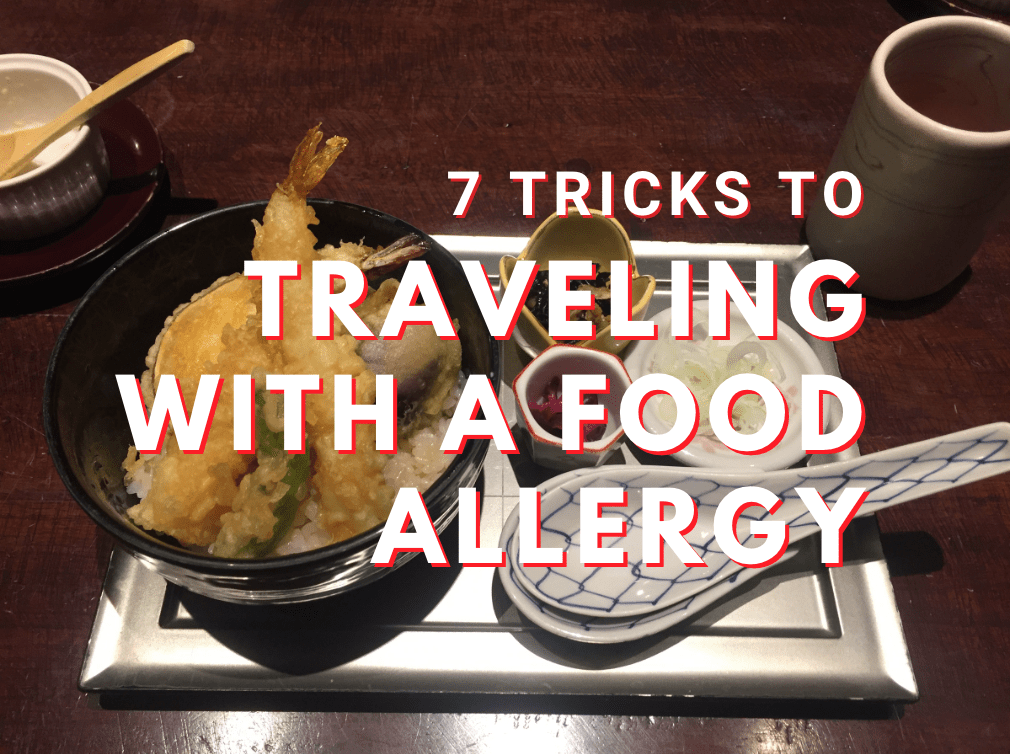Traveling With A Food Allergy
Traveling with a food allergy can be a challenge. As someone that has done it a lot I am here to tell you it doesn’t have to be what stops you from flying away – although right now COVID and/or COVID related travel restrictions might.
There are times that it has been incredibly frustrating or challenging, but life and experience has taught me how to navigate it. Here are a few tricks I have picked up along the way.
I am not a doctor. I have lived with a nut/peanut allergy for my whole life and have managed to travel to 70+ countries on 5 continents. This is meant for general informational purposes only. If you have specific questions about your personal medical situation/allergy please consult your health care provider.
#1, Have a Plan:
Having a plan doesn’t have to mean that before you sit down at any restaurant you have already mapped out a route to the hospital. This is more of a general plan on what you need to have with you on a regular basis – and then knowing what you’d do if you needed to use and or do any of the steps in your plan. Traveling with a food allergy involves making a plan. Your plan might look a bit different, but this is in general what mine looks like:
- Always carry Benadryl (ad) (or diphenhydramine).
- If my throat feels a touch itchy but I don’t know that I have eaten or even been in contact with an allergen I would take one or two. This is not in place of an epinephrine auto-injector should I be having an anaphylactic reaction. This step is because I know my body, and know my bodies reaction to an allergen well enough to know that a slight itch can usually be dealt with by taking a few Benadryl immediately. While I personally carry Benadryl, what value it can play in your allergy journey should be discussed with your allergist.
- Note: If there were ever more than one mild symptom – think itchy throat and lightheadedness, a rash, etc, that is a pretty strong indicator that your heading towards anaphylaxis and then I would go right for the auto-injector.
- The itchy throat is not the same as a sore throat. Very big difference in how they feel. This is part of learning how your body deals with your allergy. (Yay for experience?)
- Carry at least two epinephrine auto-injectors.
- This is literally the life and death part. If I’m out in the middle of nowhere having two could buy a bit of extra time. If one doesn’t work or if the person injecting me doesn’t know what they’re doing, there is a back up.
- Travel-insurance. Should you have to go to the hospital wherever you are you will have such better piece of mind if you have insurance that will cover you. Going on a slightly longer trip or are you finding yourself spending a lot of time out of country? There are international insurance options out there that cover you at home and abroad. I personally use GeoBlue (which uses the BlueCross Blue Shield network within the US) and thus far they’ve been pretty great.
- Have a credit card that works internationally: sometimes those travel insurance programs require you to pay for the costs upfront and then they reimburse you. Make sure you have a way to pay for things in whatever country your going to. I personally have Chase Sapphire Preferred.
- Have important numbers memorized and/or written down and not just in your cell phone. Say I have a reaction while ashore in a port, my cell phone dies, my external charger is on empty, and I went ashore alone. I will always have the phone number of at least one person onboard (let’s be honest, my hubby) plus the phone number for the ship with me, and not just in my cell phone. Don’t rely on just numbers in your phone. Phones die and people worry.
Education time:
- So many times when I asked what was in something I would get the response of, “well, you’ve got your auto-injector with you, right?” figuring that I would get a little sick, stab myself with a pretty darn big needle, and then we’d continue to have a happy and merry night. That’s not how it works.
- After using an epinephrine auto-injector you always need to go to the hospital. Always.
- If you inject someone with an auto-injector and symptoms don’t seem to improve after 5-10 minutes, you can inject them with a second one.
- If someone’s symptoms improve after using an auto-injector THEY STILL NEED TO GO TO A HOSPITAL. While the epinephrine will still be in the body, it’s effects in fighting off the reaction can begin to wear off somewhere in the 15-40 minute range. If you aren’t to a hospital in that range or if any symptoms seem to be coming back, inject them again. Think they’re doing fine and dandy and they seem pretty alright? Think you can go on with your night? NO. Take them to the damn hospital. Have I said it enough? Are you getting it? Take them to the hospital.
#2, Research and Notify Your Airline:
When it comes to traveling with a food allergy, flying can be particularly challenging. Not all airlines are created equal. COVID has actually made this slightly better in-flight as short flights are not really including any beverage or snack services right now. In normal times though, each airline has a slightly different policy. As allergies become more common airlines are adjusting their snacks away from peanuts, but it still happens. Notify the airline either by calling or through their “assistance” sections on their website. Delta has an option specifically for peanut/nut allergies. When you get to the gate let the gate agent know as well, they will ensure that the flight crew knows. You can also typically request pre-boarding so you can wipe down your seat area. Here’s an outline of a few airlines policies.
#3, When Flying, Bring Your Own Food:
- You can bring food! The TSA has an entire section on their website on what foods you can bring through security. Typically before you arrive at the final destination you will have to ditch any fruits, vegetables, meats, or cheeses that you haven’t finished yet, but, yes, bring a snack! Do not rely on the airline or airports (especially right now during COVID) to be able to provide allergy free sustenance for you throughout your entire journey. Bonus – it’s WAY less expensive.
- You did all the things you were supposed to do in letting them know about your allergy. You get onboard and the “nut free” meal they’ve put together for you is an apple, a banana and maybe a small salad. You see everyone else eating their “chicken and rice” or “pasta” dish and are envious. You are probably tired, you are probably frustrated as you are flying, but it’s going to be okay. You remember the snacks you brought and between that and the apples and bananas you have enough sustenance to get you through. This is not the situation to pick a fight. If you don’t like it, pick a different airline (like Delta) that is among the best when dealing with allergies.
- Right now during COVID don’t plan that there will be a place open at the airport to buy food that you can eat.
#4, Cruise Ship Buffet:
We don’t know what the buffet will look like in the near future thanks to my dear friend COVID, but I can tell you that cross contamination is your worst enemy. Traveling with a food allergy, especially on a buffet, is a time to keep your eyes open for cross contamination hazards.
When I used to work in the kids club onboard parents of children with a nut/peanut allergy would get so excited to find out I had a peanut allergy. I think they figured that I would keep their kid safe, but also because I would tell them the spots to look out for onboard.
Now, there are a lot of spots to look out for with cross contamination on a cruise ship buffet. That doens’t mean all hope is lost! Crew are getting more and more knowledgable about nut and peanut allergies and the risks of cross contamination as time goes on. If you are having a hard time finding something, or if your not confident that your allergy concerns got across the language barriers (this happens, I love my friends and crew from all around the world, but the severity of it can sometimes get lost in translation), find a manager to verify.
Cross Contamination Spots to Watch Out For on a Cruise Ship (or any buffet):
- Cookies. I skip the cookies entirely. They have gotten better in recent years to say “with nuts” and “without nuts” but I’m never quite confident that they use different tongs and how separate they are kept all the time.
- Ice cream. While I love hard ice cream so much more than most soft serve, (for the Vermonter’s out there, a creamee is obviously a different story), for nut and allergy people soft serve is sadly where it’s at. Hard ice cream presents a cross contamination hazard. The same scooper that goes in the Pecan ice cream gets slightly rinsed and then put into your cookie dough. If it is a day that only has flavors that I’m not allergic to I might go for it (me, personally). To make sure your safe though, go with soft serve. Also, side note not having to do with cruise ships – the majority of Ben and Jerry’s Scoop Shops will go get a brand new scoop and new container so you will be safe!
- Made to order pasta stations: Do they use pesto? Is that pine-nut pesto?
- Salad stations: If the salad station has nuts on it, it usually has it’s own spoon, so that’s not much of a cross contamination risk. However, if they offer to toss it for you, say no! The tongs they use to toss it were likely also used to toss a salad that had nuts on it.
- Sandwich station: If they have the dreaded PB&J my biggest recommendation would be to find something else to eat. More cross contamination hazards at that sandwich station than I can count.
- Breads/rolls/etc: A plain bread roll is where it’s at. Check the surroundings, if there is a roll that has nuts in it, skip the whole section.
- The main line – if there is nothing on it that is normally a risk, you will be fine, and most of the time they have separate tongs for separate foods. However, not always. When in doubt, leave it out!
#5, Beware the Coffee Shop:
I love a nice hot chocolate. You know what I don’t love? Everyone using almond milk and making me getting a hot chocolate (with the nice frothy milk) a cross contamination hazard. Grr! I get it, some of the people using almond milk have a milk allergy and I should be considerate to their health just like they’re considerate to mine, but still, grr. Anyways, if you are at a coffee shop and they offer almond milk, ask about if they can clean/sanitize before making your drink. If not, maybe just get a cup of hot water and bring the tea bag that you have in your purse because paying lots of money literally for a tea bag at a coffee shop is silly. Hot water will be safe (and you’ll save money!) If you’re traveling with a food allergy, vigilance and awareness of cross contamination is imperative.
And, you know why I love hot chocolate and tea so much and not coffee? Thank you hazelnut coffee and the fact that this blend and that blend don’t list what is making up that blend. Whomp.
In regards to the food at the coffee shop – well, 99% of the time I would say leave it. If it is a bakery where they make it there themselves, then ask them about it, watch how they handle other people’s food. If it’s obvious that they’re aware of the cross contamination risks, then do what feels right to you. Knowing the food doesn’t actively have nuts in it is only part of the battle.
#6, Ask and Don’t Be Subtle:
If I am out to eat, after many decades of this I basically go with something along the lines of, “I have a nut and peanut allergy, I don’t really think it will have nuts in it, but could you double check if there’s anything in (whatever I’m ordering) that might kill me?” I’ve found that mentioning that it might kill you gets a bit of a more serious reaction from the staff (as it should). Or, if it’s at a restaurant that seems like an odd place to find nuts, “hi, I know this might sound odd, but I have a nut and peanut allergy and have found that some Mexican restaurants have started putting peanuts in their enchilada sauce, could you just double check that everything is safe for me to eat?” There might be times that you feel silly asking but it’s never silly. For instance, at the Philadelphia airport there used to be a burger place that cooked all their french fries in peanut oil. It’s always worth asking.
#7, Translation Apps:
You find yourself in a country where you don’t speak the language. Technology is your friend! Even if you don’t have a translation app on your phone, simply type the phrase you want to say into Google and it will pop it out for you in any language you want. Having translation tools so readily available is a huge game changer.
Other Resources for Traveling with A Food Allergy
And, lastly, here are links to some great websites that are full of information both about traveling with a food allergy but also navigating life:
- Anaphylaxis Campaign
- Allergic Living
- American Academy of Allergy, Asthma, and Immunology
- Asthma and Allergy Foundation of America
- Equal Eats – Allergy Translation Cards
Like what you read and want to support this blog?






